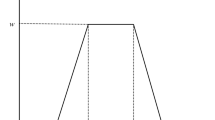Abstract
Metros are critical infrastructure in big cities and evaluation of their safe operation is of increasing importance. To make a reasonable safety evaluation for the metro during operation, this paper establishes a rational safety evaluation model based on long-term monitoring data of Shanghai Metro Line 2. Four evaluation indicators, i.e., absolute settlement, relative curvature, deformation rate and curvature radius, are adopted. Analytic hierarchy process (AHP) and entropy method are combined to determine the weights of the indicators. The risk level values at different mileage are calculated and five danger levels are defined accordingly to determine the safety state of Shanghai Metro Line 2, i.e., safe, relatively safe, critical, relatively dangerous, and dangerous. Safety evaluation of Shanghai Metro Line 2 shows that: 83.81% areas of Shanghai Metro Line 2 are in safe, relatively safe and critical states, while 15.63% and 0.57% areas are in relatively dangerous and dangerous states, respectively; the parts of Shanghai Metro Line 2 where the risk level value exceeds the critical value are mainly distributed around the mileage at 6.0–7.5 km and 8.5–11.0 km, and the risk level value peaks around the mileage at 7.3 km, in which high attention should be attached and relevant protective measures be taken; the sections with the high risk level value coincide with the distinctly deforming areas of the metro, indicating that this evaluation method is valid.
Similar content being viewed by others
References
OCAK I. Control of surface settlements with umbrella arch method in second stage excavations of Istanbul Metro [J]. Tunnelling and Underground Space Technology, 2008, 23(6): 674–681.
SADAGHIANI M H, DADIZADEH S. Study on the effect of a new construction method for a large span metro underground station in Tabriz-Iran [J]. Tunnelling and Underground Space Technology, 2010, 25(1): 63–69.
AVCI O, OZBULUT O. Threat and vulnerability risk assessment for existing subway stations: A simplified approach [J]. Case Studies on Transport Policy, 2018, 6(4): 663–673.
HUANG H W, YE Y F, HU Q F. Analysis on the current situation of risk management on metro operation safety [J]. China Safety Science Journal, 2008, 18(7): 55–62 (in Chinese).
LI X J. Analysis on the safety risk of subway operation [J]. Journal of Engineering Management, 2017, 31(1): 83–88 (in Chinese).
TAGUCHI M, KAWAKAMI K, KONISHI S, et al. Development of maintenance indicator to evaluate soundness of subway tunnels [J]. Procedia Engineering, 2016, 165: 155–165.
XU T K. Study on risk assessment theory and methods on urban rail transit net work operation [D]. Beijing, China: Beijing Jiaotong University, 2012 (in Chinese).
WANG Y H, HUANG Y K, LI M. Evaluation of urban rail transit line operational safety based on combination weighing method [J]. Journal of Tongji University (Natural Science), 2013, 41(8): 1243–1248 (in Chinese).
PANG T. Research on standard system of metro operation safety [D]. Sichuan, China: Southwest Jiaotong University, 2017 (in Chinese).
ZHANG H Y. Urban rail transit safety evaluation and countermeasures research [D]. Lanzhou, China: Lanzhou Jiaotong University, 2013 (in Chinese).
SAATY T L. A scaling method for priorities in hierarchical structures [J]. Journal of Mathematical Psychology, 1977, 15(3): 234–281.
KANCHANA J, PRASATH V, KRISHNARAJ V, et al. Multi response optimization of process parameters using grey relational analysis for milling of hardened Custom 465 steel [J]. Procedia Manufacturing, 2019, 30: 451–458.
SKULMOSKI G J, HARTMAN F T, KRAHN J. The Delphi method for graduate research [J]. Journal of Information Technology Education, 2007, 6(1): 1–21.
SONG G X, YANG D L. Combination weighting approach based on the decision-maker’s preference and consistency of weighting methods [J]. Systems Engineering and Electronics, 2004, 26(9): 1226–1229 (in Chinese).
JIA S K, WEN X H, LIN D J, et al. Study on safety assessment techniques for subway operation system based on analytic hierarchy process [J]. China Safety Science Journal, 2008, 18(5): 137–141 (in Chinese).
LIANG G L, XU W Y, TAN X L. Application of extension theory based on entropy weight to rock quality evaluation [J]. Rock and Soil Mechanics, 2010, 31(2): 535–540 (in Chinese).
Shanghai Municipal Engineering Administration Bureau. Interim provisions on the management of metro protection for construction protection along the shanghai metro line [EB/CD]. (2018-3-5) [2019-10-12]. http://dtjh.shmetro.com/MMSW/front/lookLaws/4 (in Chinese).
RAN A L, LI M G, CHEN J J, et al. Deformation behaviors of joint between shield tunnel and underground station impacted by connected deep foundation pit [J]. Tunnel Construction, 2016, 36(7): 844–850 (in Chinese).
LIU T J. Study on control values of bending moment and deformation of shield-bored metro tunnels [J]. Tunnel Construction, 2010, 30(Sup. 1): 109–112 (in Chinese).
SHANNON C E. A mathematical theory of communication [J]. The Bell System Technical Journal, 1948, 27(3): 379–423.
Author information
Authors and Affiliations
Corresponding author
Additional information
Foundation item
the National Natural Science Foundation of China (Nos. 41602283 and 41977216), and the Science and Technology Rising-Star Program of Shanghai (No. 19QC1400800)
Rights and permissions
About this article
Cite this article
Cao, W., Li, M., Wu, W. et al. Safety Evaluation Method for Long-Term Operation of Metro Based on Combination Weighting Method. J. Shanghai Jiaotong Univ. (Sci.) 25, 700–705 (2020). https://doi.org/10.1007/s12204-020-2230-z
Received:
Published:
Issue Date:
DOI: https://doi.org/10.1007/s12204-020-2230-z




